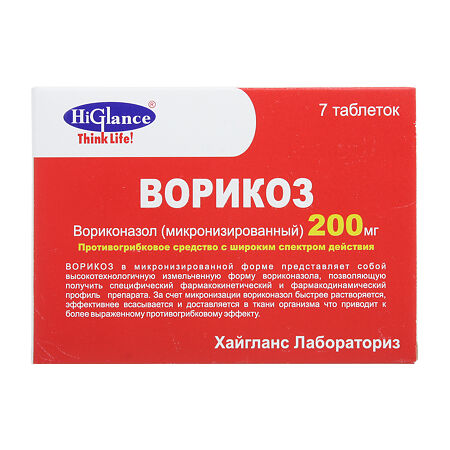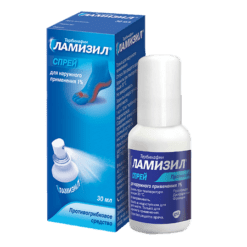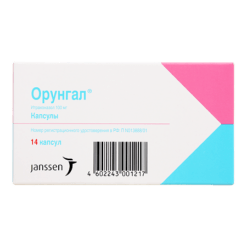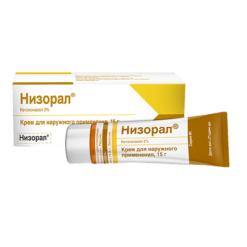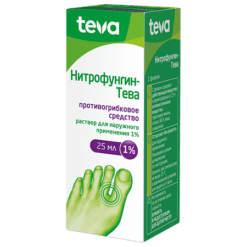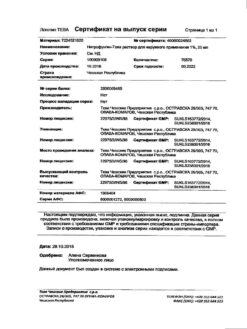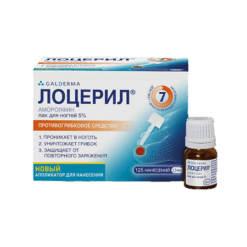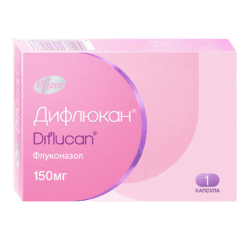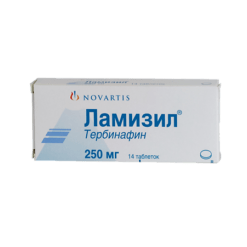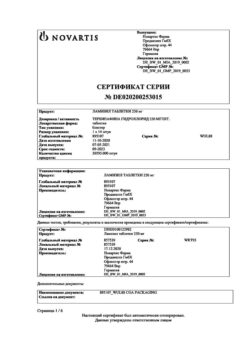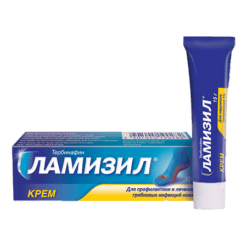No products in the cart.
Voricosis, 200 mg 7 pcs
€1.00
Out of stock
(E-mail when Stock is available)
Description
Voriconazole is a broad-spectrum antifungal agent of the triazole group. The mechanism of action is related to the inhibition of 14α-sterol demethylation mediated through fungal cytochrome P450; this reaction is a key step in ergosterol biosynthesis. Accumulation of 14α-methylsterol correlates with the subsequent loss of ergosterol in fungal cell membranes, which determines the antifungal activity of voriconazole.
Indications
Indications
esophageal candidiasis;
severe fungal infections caused by Scedosporium spp. and Fusarium spp.;
other severe invasive fungal infections with intolerance or refractoriness to other drugs;
invasive aspergillosis;
candidemia in patients without neutropenia;
severe invasive forms of candidal infections (including Candida krusei);
prevention of “breakthrough” fungal infections in patients with reduced immune system function, fever and neutropenia, from high-risk groups (hematopoietic stem cell transplant recipients, patients with relapsed leukemia);
prevention of invasive fungal infections in high-risk patients (adults and children over 12 years of age), such as hematopoietic stem cell transplant recipients.
Pharmacological effect
Pharmacological effect
Voriconazole is a broad-spectrum antifungal drug from the triazole group. The mechanism of action is associated with inhibition of 14α-sterol demethylation mediated through fungal cytochrome P450; this reaction is a key step in the biosynthesis of ergosterol. Accumulation of 14α-methylsterol correlates with subsequent loss of ergosterol in fungal cell membranes, which mediates the antifungal activity of voriconazole.
Active ingredient
Active ingredient
Voriconazole
Composition
Composition
Each film-coated tablet contains:
Pregnancy
Pregnancy
There is not enough information on the use of the drug in pregnant women.
Contraindications
Contraindications
Hypersensitivity to voriconazole or other components of the drug.
Side Effects
Side Effects
The most common adverse reactions are visual disturbances, abnormal liver function test results, fever, rash, vomiting, nausea, diarrhea, headache, peripheral edema, abdominal pain, and respiratory depression. Adverse reactions were usually mild or moderate. No clinically significant relationship between the safety of the drug and age, race or gender was identified.
Frequency assessment criteria: very common ≥ 10%; often ≥ 1% and
Cardiac disorders: often – supraventricular arrhythmia, tachycardia, bradycardia; uncommon – ventricular fibrillation, ventricular extrasystole, ventricular tachycardia, supraventricular tachycardia; rarely – pirouette-type arrhythmia, complete atrioventricular block, bundle branch block, nodal arrhythmias.
Vascular disorders: often – arterial hypotension, phlebitis; infrequently – thrombophlebitis.
Disorders of the hematopoietic and lymphatic systems: often – agranulocytosis, pancytopenia, thrombocytopenia, anemia; uncommon – bone marrow depression, leukopenia, lymphadenopathy, eosinophilia, disseminated intravascular coagulation syndrome.
From the nervous system: very often – headache; often – syncope, tremor, dizziness, convulsions, nystagmus, paresthesia, drowsiness, dizziness; uncommon – cerebral edema, encephalopathy, extrapyramidal disorder, peripheral neuropathy, ataxia, hypoesthesia, dysgeusia (impaired taste perception); rarely – hepatic encephalopathy, Guienne-Barré syndrome.
From the organ of vision: very often – visual impairment (blurred vision, chromotopsia, photophobia); often – hemorrhage into the retina of the eye; uncommon – optic neuritis, papilledema, oculogyric crisis, scleritis, diplopia, blepharitis; rarely – optic nerve atrophy, corneal opacification.
Disturbances of the organ of hearing and vestibular apparatus: infrequently – vertigo, hypoacusis, tinnitus.
Disorders of the respiratory system, chest and mediastinum: often – pulmonary edema, acute respiratory distress syndrome; very often – respiratory depression.
Gastrointestinal disorders: very often – nausea, vomiting, diarrhea, abdominal pain; often – cheilitis, dyspepsia, constipation; infrequently – duodenitis, glossitis, pancreatitis, swelling of the tongue.
Renal and urinary tract disorders: often – acute renal failure, hematuria; uncommon – renal tubular necrosis, proteinuria, nephritis.
Disorders of the skin and subcutaneous tissues: very often – rash; often – exfoliative dermatitis, alopecia, itching, maculopapular rash, erythema; uncommon – toxic epidermal necrolysis, angioedema, erythema multiforme, psoriasis, allergic dermatitis, Stevens-Johnson syndrome, photosensitivity, urticaria, purpura, papular rash, macular rash, eczema; rarely – pseudoporphyria, persistent drug erythema; frequency unknown – cutaneous form of systemic lupus erythematosus.
Disorders of the musculoskeletal system and connective tissue: often – back pain; infrequently – arthritis; frequency unknown – periostitis.
Endocrine system disorders: infrequently – adrenal insufficiency, hypothyroidism, rarely – hyperthyroidism.
Metabolic and nutritional disorders: very often – peripheral edema, often – hypokalemia, hypoglycemia, hyponatremia (detected in post-registration studies).
Infections and infestations: often – sinusitis, gastroenteritis, gingivitis; uncommon – pseudomembranous colitis, lymphangitis, peritonitis.
General disorders: very often – pyrexia; often – flu-like illness, chills, asthenia, chest pain, swelling of the face (periorbital edema, swelling of the lips, swelling of the mouth).
Immune system disorders: uncommon – allergic reactions; rarely – anaphylactoid reactions.
Disorders of the hepatobiliary system: very often – abnormal liver function test results, increased activity of aspartate aminotransferase, alanine aminotransferase, alkaline phosphatase, gamma-glutamyltransferase, lactate dehydrogenase, hyperbilirubinemia; often – jaundice, cholestatic jaundice, hepatitis; uncommon – cholecystitis, cholelithiasis, liver enlargement, liver failure.
Mental disorders: often – hallucinations, depression, anxiety, insomnia, agitation, confusion.
Neoplasms benign, malignant and unspecified (including cysts and polyps): frequency unknown – squamous cell carcinoma of the skin.
Studies: often – increased concentration of creatinine in the blood, infrequently – prolongation of the QT interval on the electrocardiogram, increased concentration of urea in the blood, increased concentration of cholesterol in the blood.
Side effects when used in children
It was found that the adverse effects of the drug in children aged 3 to 12 years are similar to those in adults. A higher incidence of elevated liver enzymes was observed in children. Post-registration studies revealed the development of pancreatitis in children during voriconazole therapy, as well as a more frequent occurrence of skin reactions.
Interaction
Interaction
Concomitant use of voriconazole with the following medicinal products is contraindicated. St. John’s wort has a short initial inhibitory effect on the metabolism of voriconazole, followed by its activation.
Overdose
Overdose
Treatment: the antidote for voriconazole is not known; if necessary, symptomatic therapy is carried out, gastric lavage is possible. Voriconazole is eliminated by hemodialysis with a clearance of 121 ml/min.
Storage conditions
Storage conditions
Store in a dry place, protected from light, at a temperature of 8 °C to 25 °C.
Shelf life
Shelf life
3 years.
Manufacturer
Manufacturer
Highglans Laboratories Pvt. Ltd, India
Additional information
| Shelf life | 3 years. |
|---|---|
| Conditions of storage | Store in a dry, light-protected place at 8 °C to 25 °C. |
| Manufacturer | Hyglans Laboratories Pvt. Ltd, India |
| Medication form | pills |
| Brand | Hyglans Laboratories Pvt. Ltd |
Related products
Buy Voricosis, 200 mg 7 pcs with delivery to USA, UK, Europe and over 120 other countries.

